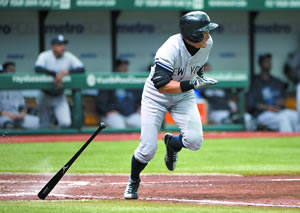Ichiro’s Legacy Not Hits, But Impact

New York Yankees’ Ichiro Suzuki heads to first base after singling during the sixth inning of a game against the Tampa Bay Rays Aug. 25 in St. Petersburg, Fla. | AP photo/Phelan M. Ebenhack
Sadaharu Oh suffers the same fate in regard to besting Barry Bonds as the game’s best home-run hitter.
But records aren’t the point.
Ichiro’s 4,000 hits at the major league level (note the lower-case m) further establishes the Yankees’ right fielder as one of the most important players in baseball history. He’s not Jackie Robinson (nor the often-forgotten Larry Doby, who followed Robinson by three months while integrating the American League in 1947), but Ichiro opened the door for Asian players who in the past had been deemed unqualified for the Major Leagues. In doing so, he also lifted the reputation of the Japan major leagues, while creating new markets for MLB’s product.
Ichiro, and the Japanese players who followed, turned breakfast in Japan into prime baseball viewing time. Nearly every day one can find a Yankees, Mariners or Red Sox game on Japanese television. The national following of the country’s top stars created massive revenue streams for baseball. According to Sports Business Daily, 70 percent of Major League Baseball’s international revenue comes from Japan. Ichiro equals dollars.
The Seattle Mariners experienced a 60 percent increase in licensed merchandise after Ichiro’s arrival in 2001, and his popularity increased MLB’s business by 10 percent, says MLB.com. Attendance at Mariners’ games that year increased more than 12 percent as the “Ichiro effect,” as it became known, spread beyond the ball park.
In 2011, his last full season with the Mariners, 64,000 Japanese visitors came to Seattle – twice the number of Chinese visitors who make up the second largest segment of Asian visitors to the area. The result was the Mariners becoming one of the league’s most financially stable teams.
According to Forbes, the team had an operating income of $10.8 million in 2004. This was compared to the Yankees, who ran at an operating loss of $37 million. Seattle had baseball’s third-highest television rating in 2005 (based on its share of the local TV market) and was in the middle of a 10-year, $250 million local TV deal that was the fourth highest among MLB teams.
All this makes his $13 million posting fee – the amount a Major League club pays to a NPB club for the right to negotiate with a player – a bargain.
Of course, none of this would have happened had Ichiro been anything but an amazing talent.
That he could hit at the Major League level was obvious. He led the Pacific League in hitting seven consecutive seasons, and in his final season in Japan he hit a pitch that bounced 6 inches in front of home plate. His speed was expected, but at 5-feet-11-inches and 170 pounds, his arm was a bigger surprise. He’s Kaline and Clemente right-field-good.
If there is a knock on Ichiro, it’s the thing that made him great – his aggressive nature as a hitter. For a lead-off hitter with such excellent bat control, he has a paltry number of walks and comparatively high number of strikeouts.
In his Major League career, he’s averaged 43 walks and 68 strikeouts per season.
More seriously, it has kept him from making a run at becoming the first player since Ted Williams to hit .400. More than George Brett (.390 in 1980) or Tony Gwynn (.394 in 1994), Ichiro had the skills to make it close. But with an average of 679 at bats per season, it just wasn’t going to happen.



